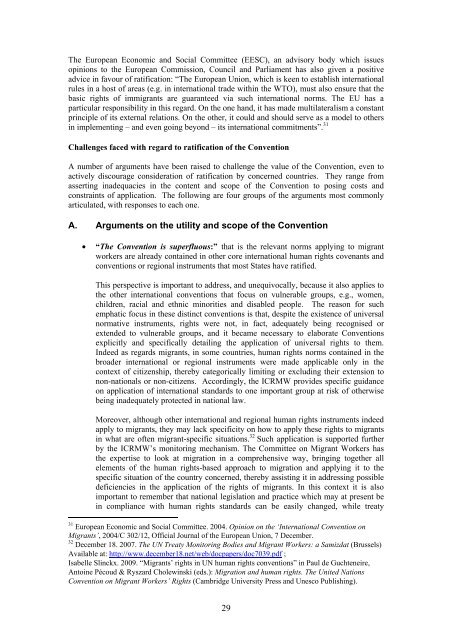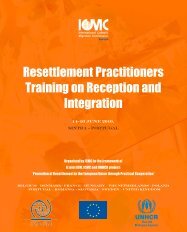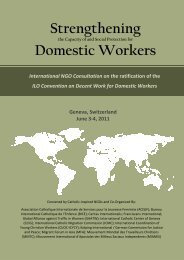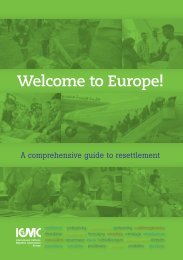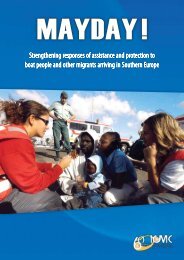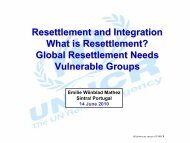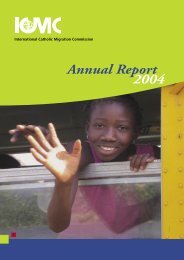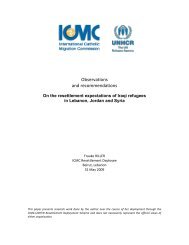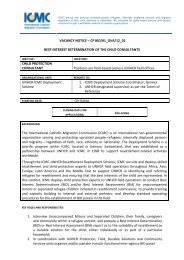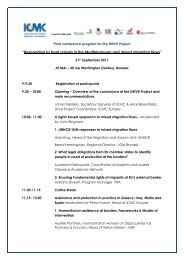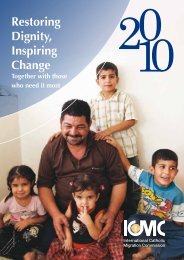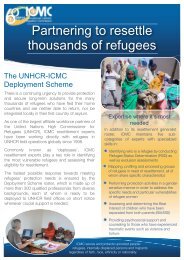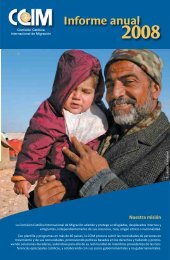Guide on ratification of the Migrant Workers Convention
Guide on ratification of the Migrant Workers Convention
Guide on ratification of the Migrant Workers Convention
Create successful ePaper yourself
Turn your PDF publications into a flip-book with our unique Google optimized e-Paper software.
The European Ec<strong>on</strong>omic and Social Committee (EESC), an advisory body which issues<br />
opini<strong>on</strong>s to <strong>the</strong> European Commissi<strong>on</strong>, Council and Parliament has also given a positive<br />
advice in favour <strong>of</strong> ratificati<strong>on</strong>: “The European Uni<strong>on</strong>, which is keen to establish internati<strong>on</strong>al<br />
rules in a host <strong>of</strong> areas (e.g. in internati<strong>on</strong>al trade within <strong>the</strong> WTO), must also ensure that <strong>the</strong><br />
basic rights <strong>of</strong> immigrants are guaranteed via such internati<strong>on</strong>al norms. The EU has a<br />
particular resp<strong>on</strong>sibility in this regard. On <strong>the</strong> <strong>on</strong>e hand, it has made multilateralism a c<strong>on</strong>stant<br />
principle <strong>of</strong> its external relati<strong>on</strong>s. On <strong>the</strong> o<strong>the</strong>r, it could and should serve as a model to o<strong>the</strong>rs<br />
in implementing – and even going bey<strong>on</strong>d – its internati<strong>on</strong>al commitments”. 31<br />
Challenges faced with regard to ratificati<strong>on</strong> <strong>of</strong> <strong>the</strong> C<strong>on</strong>venti<strong>on</strong><br />
A number <strong>of</strong> arguments have been raised to challenge <strong>the</strong> value <strong>of</strong> <strong>the</strong> C<strong>on</strong>venti<strong>on</strong>, even to<br />
actively discourage c<strong>on</strong>siderati<strong>on</strong> <strong>of</strong> ratificati<strong>on</strong> by c<strong>on</strong>cerned countries. They range from<br />
asserting inadequacies in <strong>the</strong> c<strong>on</strong>tent and scope <strong>of</strong> <strong>the</strong> C<strong>on</strong>venti<strong>on</strong> to posing costs and<br />
c<strong>on</strong>straints <strong>of</strong> applicati<strong>on</strong>. The following are four groups <strong>of</strong> <strong>the</strong> arguments most comm<strong>on</strong>ly<br />
articulated, with resp<strong>on</strong>ses to each <strong>on</strong>e.<br />
A. Arguments <strong>on</strong> <strong>the</strong> utility and scope <strong>of</strong> <strong>the</strong> C<strong>on</strong>venti<strong>on</strong><br />
• “The C<strong>on</strong>venti<strong>on</strong> is superfluous:” that is <strong>the</strong> relevant norms applying to migrant<br />
workers are already c<strong>on</strong>tained in o<strong>the</strong>r core internati<strong>on</strong>al human rights covenants and<br />
c<strong>on</strong>venti<strong>on</strong>s or regi<strong>on</strong>al instruments that most States have ratified.<br />
This perspective is important to address, and unequivocally, because it also applies to<br />
<strong>the</strong> o<strong>the</strong>r internati<strong>on</strong>al c<strong>on</strong>venti<strong>on</strong>s that focus <strong>on</strong> vulnerable groups, e.g., women,<br />
children, racial and ethnic minorities and disabled people. The reas<strong>on</strong> for such<br />
emphatic focus in <strong>the</strong>se distinct c<strong>on</strong>venti<strong>on</strong>s is that, despite <strong>the</strong> existence <strong>of</strong> universal<br />
normative instruments, rights were not, in fact, adequately being recognised or<br />
extended to vulnerable groups, and it became necessary to elaborate C<strong>on</strong>venti<strong>on</strong>s<br />
explicitly and specifically detailing <strong>the</strong> applicati<strong>on</strong> <strong>of</strong> universal rights to <strong>the</strong>m.<br />
Indeed as regards migrants, in some countries, human rights norms c<strong>on</strong>tained in <strong>the</strong><br />
broader internati<strong>on</strong>al or regi<strong>on</strong>al instruments were made applicable <strong>on</strong>ly in <strong>the</strong><br />
c<strong>on</strong>text <strong>of</strong> citizenship, <strong>the</strong>reby categorically limiting or excluding <strong>the</strong>ir extensi<strong>on</strong> to<br />
n<strong>on</strong>-nati<strong>on</strong>als or n<strong>on</strong>-citizens. Accordingly, <strong>the</strong> ICRMW provides specific guidance<br />
<strong>on</strong> applicati<strong>on</strong> <strong>of</strong> internati<strong>on</strong>al standards to <strong>on</strong>e important group at risk <strong>of</strong> o<strong>the</strong>rwise<br />
being inadequately protected in nati<strong>on</strong>al law.<br />
Moreover, although o<strong>the</strong>r internati<strong>on</strong>al and regi<strong>on</strong>al human rights instruments indeed<br />
apply to migrants, <strong>the</strong>y may lack specificity <strong>on</strong> how to apply <strong>the</strong>se rights to migrants<br />
in what are <strong>of</strong>ten migrant-specific situati<strong>on</strong>s. 32 Such applicati<strong>on</strong> is supported fur<strong>the</strong>r<br />
by <strong>the</strong> ICRMW’s m<strong>on</strong>itoring mechanism. The Committee <strong>on</strong> <strong>Migrant</strong> <strong>Workers</strong> has<br />
<strong>the</strong> expertise to look at migrati<strong>on</strong> in a comprehensive way, bringing toge<strong>the</strong>r all<br />
elements <strong>of</strong> <strong>the</strong> human rights-based approach to migrati<strong>on</strong> and applying it to <strong>the</strong><br />
specific situati<strong>on</strong> <strong>of</strong> <strong>the</strong> country c<strong>on</strong>cerned, <strong>the</strong>reby assisting it in addressing possible<br />
deficiencies in <strong>the</strong> applicati<strong>on</strong> <strong>of</strong> <strong>the</strong> rights <strong>of</strong> migrants. In this c<strong>on</strong>text it is also<br />
important to remember that nati<strong>on</strong>al legislati<strong>on</strong> and practice which may at present be<br />
in compliance with human rights standards can be easily changed, while treaty<br />
31 European Ec<strong>on</strong>omic and Social Committee. 2004. Opini<strong>on</strong> <strong>on</strong> <strong>the</strong> ‘Internati<strong>on</strong>al C<strong>on</strong>venti<strong>on</strong> <strong>on</strong><br />
<strong>Migrant</strong>s’, 2004/C 302/12, Official Journal <strong>of</strong> <strong>the</strong> European Uni<strong>on</strong>, 7 December.<br />
32 December 18. 2007. The UN Treaty M<strong>on</strong>itoring Bodies and <strong>Migrant</strong> <strong>Workers</strong>: a Samizdat (Brussels)<br />
Available at: http://www.december18.net/web/docpapers/doc7039.pdf ;<br />
Isabelle Slinckx. 2009. “<strong>Migrant</strong>s’ rights in UN human rights c<strong>on</strong>venti<strong>on</strong>s” in Paul de Guchteneire,<br />
Antoine Pécoud & Ryszard Cholewinski (eds.): Migrati<strong>on</strong> and human rights. The United Nati<strong>on</strong>s<br />
C<strong>on</strong>venti<strong>on</strong> <strong>on</strong> <strong>Migrant</strong> <strong>Workers</strong>’ Rights (Cambridge University Press and Unesco Publishing).<br />
29


